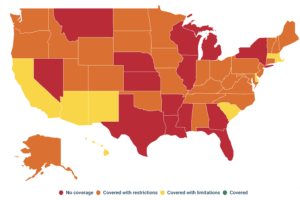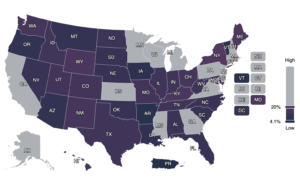Mapping the State of Obesity Care Coverage – A Rundown of Recent Data
July 31, 2024
A comprehensive look at insurance coverage of obesity care across the nation
A newly developed interactive resource from the Robert Wood Johnson Foundation uses a heat map to provide insights into the current state of health insurance for obesity care in the United States, allowing users to visualize the impact of policymaker, insurer and employer decisions on access to this important care.
Key findings from the dataset underscore challenges with access to care, particularly for obesity medications:
- In 34 out of 50 states, less than 20% of the population has a health insurance plan that covers the latest generation of obesity medications.
- Almost 75% of people with health insurance do not have coverage for the newest generation of obesity medications.
A state-by-state guide to Medicaid coverage of obesity care
Coverage of obesity care by state Medicaid programs remains low according to a recent map developed by the STOP Obesity Alliance and the Obesity Action Coalition. This analysis reveals that 14 state Medicaid programs do not cover obesity care options – including nutritional counseling, intensive behavioral therapy, obesity medications and surgery. These states include Arkansas, Florida, Georgia, Illinois, Kansas, Louisiana, Michigan, Mississippi, Montana, Nebraska, Nevada, New York, Texas, and Wisconsin.
The remaining states offer coverage with restrictions and limitations. But, we are seeing progress in some states, with North Carolina’s Medicaid program adding coverage for obesity medication beginning on August 1. 
Spurring momentum for coverage
Coverage of comprehensive obesity care benefits everybody, as the disease has significant and detrimental health and financial impacts:
- Obesity is associated with over 200 other health complications, including heart disease, diabetes, and cancer.
- In 2023, obesity and overweight were estimated to have cost US businesses and employees $425.5 billion in economic costs.
- Collectively, diseases caused by obesity cost our nation’s healthcare system more than $1.7 trillion every year.
- In 2022, per million population, obesity raised state costs for Medicaid, public assistance, and state government health insurance by $83.5 million.
Employer coverage of obesity care is increasing, with about half of employers currently covering or considering covering obesity medications for employees. This is positive momentum, and now public insurance plans must follow suit.
Meanwhile, for those on Medicare, there has been some movement on the Treat and Reduce Obesity Act (TROA): a narrower, amended version was just passed by the House Ways and Means Committee and is now with the House Committee on Energy & Commerce for advancement.
To find out how you can help improve coverage for obesity care, click here.
